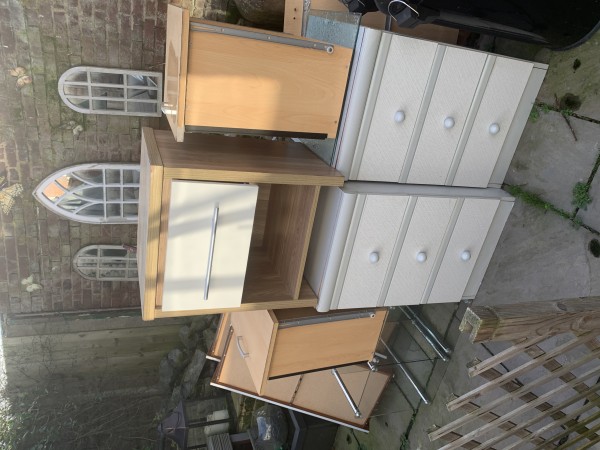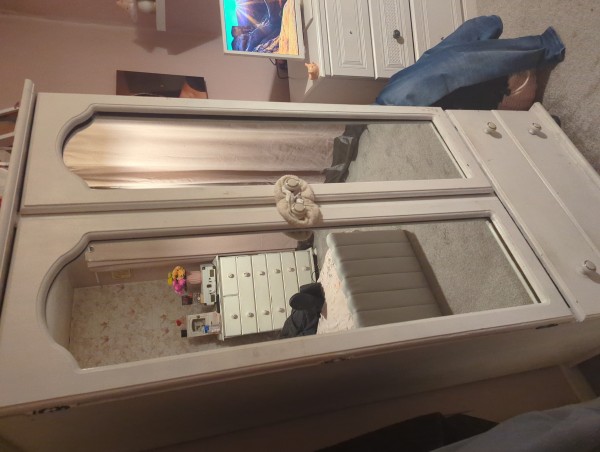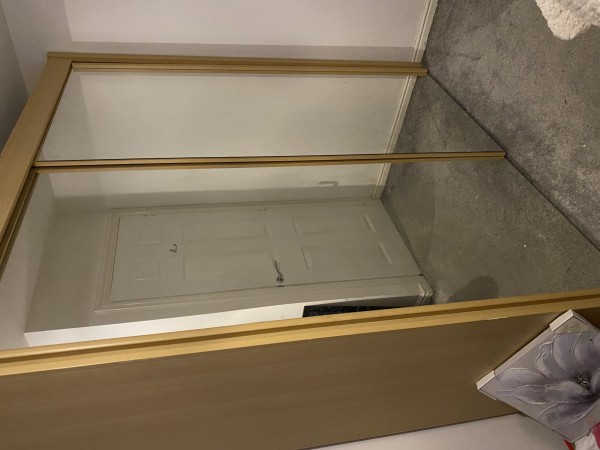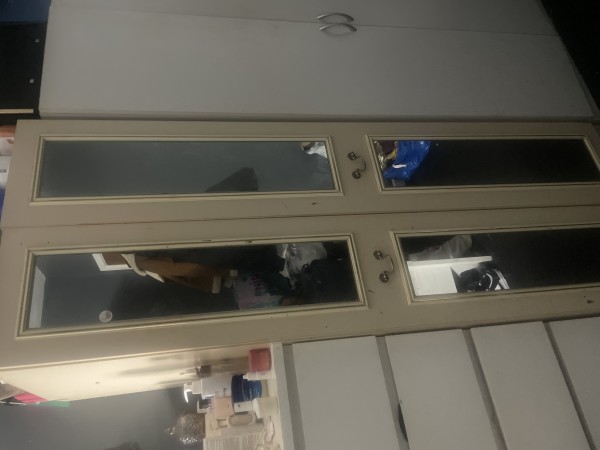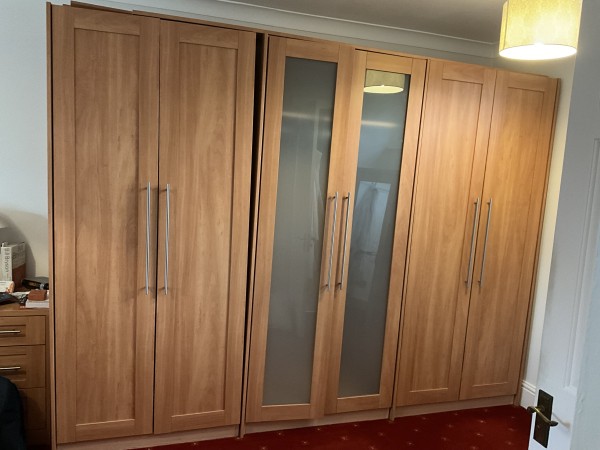Wardrobe and Drawer Removal & Disposal Service: Comprehensive Guide
 Edited by Ali Lijee
Edited by Ali Lijee
Need to get rid of a wardrobe or drawer from your home? Our man and van teams can help.
Getting lost in the fantastical world of Narnia may be fun for children and adults alike who are fans of C.S. Lewis’ The Lion, the Witch and the Wardrobe, but it shouldn’t be taken literally. If you’re getting lost in the mess found within your wardrobe, it may be time to replace your wardrobe with a brand new armoire or fitted wardrobe in your home.
Rubbish.com can help you get rid of your unwanted wardrobe, dresser, armoire, nightstand, chest of drawers, or other heavy furniture at affordable prices.
We remove & dispose of wardrobes and drawers
Table of contents:
- Wardrobe and drawer removal & disposal services UK
- Wardrobe and drawer removal service near you
- Gallery of wardrobes and drawers we have removed
- Wardrobe and drawer removal & disposal: questions people commonly ask
Wardrobe and drawer removal & disposal services UK
For the everyday family to the classiest of sartorialists, the wardrobe is essential for storing trousers, shirts, a spring jacket, and all of those cosy jumpers for the cool autumn and cold winter months. Wardrobes and other furniture common in bedrooms such as nightstands, dressers, and armoires can be quite bulky and heavy, however, particularly if they’re old and made of quality timber.
This can make wardrobe & drawer removal and disposal a laborious affair should you ever need to get rid of your unwanted furniture. Get a helping hand from the qualified and licensed waste carriers listed on Rubbish.com.
Wardrobe and drawer removal service near you
For dependable wardrobe & drawer removal in the UK at competitive prices, look no further than Rubbish.com. Our hardworking man and van partners can assist with the removal of all manner of wardrobes, chests of drawers, dressers, armoires, nightstands, gentleman’s chests, linen cabinets, kitchen cabinet drawers, tallboys, and more.
Gallery of wardrobes and drawers we have removed
Wardrobe and drawer removal & disposal: questions people commonly ask
How do I remove an old wardrobe?
Old wardrobes tend to be a lot heavier and harder to move than newer wardrobes. Removing an old wardrobe from your home may require removing the doors from the hinges, removing all drawers and shelves, detaching the clothes rail, then disassembling the frame of the wardrobe starting by the top, then the side panels and interior, and lastly by sorting and disposing of all waste.
Old wardrobes made of high-quality timber can be recycled or upcycled into high-quality furniture, greatly reducing needless waste from ending up at the council tip.
How do you move a wardrobe without dismantling it?
Bulky, heavy wardrobes often need to be dismantled in order to be removed from a home, but it may be possible to move the wardrobe without dismantling it at all. First, remove all contents to lighten the weight and consider removing any drawers or shelves as well. Then, carefully tilt the wardrobe and attach furniture sliders below the corners. Next, attach a sturdy rope or strap around the wardrobe and push/pull it to the desired location. A furniture dolly can also be used to move the wardrobe.
Can fitted wardrobes be removed?
Fitted wardrobes can be removed if they are freestanding and not attached to the walls or floor. Custom-built wardrobes that appear to be fitted to the aesthetic style of your bedroom can be removed and disposed of just like any other wardrobe so long as they are not built directly into the room. In this case, the bedroom will need to be remodelled and the fitted wardrobes will need to be dismantled in order to be removed.
How do you move a full wardrobe?
The best way to move a full wardrobe is typically to empty the wardrobe of all of its contents. This makes the task of moving the wardrobe much safer and easier. Start by removing all clothing and other objects inside of the wardrobe, organising and storing them as required. Then, remove all shelving and drawers as well as the clothes rail and any other detachable components. Consider using this opportunity to dust and clean these if the wardrobe is not destined for recycling or the council tip.
Depending on whether your wardrobe can be easily dismantled or not, you may wish to dismantle it to facilitate moving or if the wardrobe is going to be disposed of. If you are moving the wardrobe to another room or another home, consider using a furniture dolly or furniture sliders and rope to safely move the wardrobe within the home. Ask for assistance to move the wardrobe up or down flights of stairs and for loading/unloading to a vehicle for hauling.
Can you disassemble a wardrobe?
You may need to disassemble your wardrobe if you are moving it into a room or another home and it cannot fit through the door when fully assembled, or if you want to dispose of it and manage the waste more easily.
Depending on the construction of your wardrobe, you may require pliers, a screwdriver, a mallet and other tools to disassemble the various components of the wardrobe. Panels of the wardrobe that have been glued together need to be dislodged with the gentle smack of a mallet. Be sure to keep all panels and components organised so that the wardrobe can be reassembled at its destination.
How do removal companies move wardrobes?
Most removal companies in the UK can remove the entire wardrobe - including all contents - and haul it to your new home. This can be helpful for moving, but it could be problematic if you intend to dispose of the wardrobe.
Rubbish removal companies should always ask you if you want to keep the contents of your wardrobe before hauling it. Otherwise, they will assume that all contents need to be disposed of as well.
How do I move a heavy wardrobe by myself?
The best way to move a heavy wardrobe by yourself is to completely disassemble the wardrobe, piece by piece. Do not attempt to lift a heavy wardrobe alone as this can lead to serious injury.
Begin by removing all contents followed by all drawers, shelves, and the clothes rail. Begin disassembly by removing doors from their hinges, then removing the back, top, side, and bottom panels. Organise all disassembled panels and components to make reassembly easier.
How do you move a large heavy wardrobe?
The two most important considerations for moving a large heavy wardrobe are to have enough people to move it safely and to use the correct technique when lifting. Always ask for help when moving large, heavy, and bulky furniture such as wardrobes. When lifting, always make sure that your legs are doing the heavy lifting, not your back.
You may wish to use dollies attached to your shoulders or forearms to help direct the load to your legs and not to your back while also giving much-needed leverage when lifting with your leg muscles.
How do you remove a dresser drawer that doesn't pull out?
If your dresser drawer refuses to pull out completely, it could either be stuck or it could have a stopping mechanism in place to prevent it from accidentally falling out.
- To remove wood-glide and free-rolling dresser drawers, pull the drawer out as far as it will go. If the drawer meets resistance when being pulled out, try pushing the drawer down to lift up the back and then try to pull out.
- To remove metal-glide dresser drawers, open the drawer as much as possible to identify the metal levers along the sides. Press down (or rarely, pull up) the levers on both the left and right sides of the drawer and pull the drawer out.
Why won't my dresser drawers come out?
Dresser drawers might get stuck for a variety of reasons, whether as part of their design to not fall out or because of an obstruction preventing the drawer from coming out or sliding.
Try to exert light pressure on the drawer and wiggle it outwards as much as possible. Try pushing the drawer down to lift up the back, then sliding or wiggling it out.
If the dresser drawer is still stuck, try using a butter knife along the sides of the drawer where the glide mechanism is located to knock away any debris that might be obstructing it.
Why can't I get the drawers out of my dresser?
Drawers often cannot completely come out of a dresser because they have a stopping mechanism or a simple raised lip on the gliding track to prevent them from accidentally falling out. If your drawer has clips or levers along the sides, either press the levers down to remove the drawer or remove any clips holding the drawer in place.
Dresser drawers that still won’t come out may be obstructed by debris. Remove the debris with a butter knife or small implement and try to wiggle the drawer out using the above techniques.
How do you remove a wooden drawer?
Wooden drawers most commonly come with wooden (wood-on-wood) or metal slides, ball bearing slides, or soft-close slides that keep the drawer in place and that facilitate movement. To remove a wooden drawer, it is first important to understand what type of guide is used and how to dislodge it so that the drawer can be removed.
Engage the lever or slide mechanism and pull the drawer out or pull the drawer as far as it will go and tilt it down so that the back is raised, then pull out. Most wooden drawers will come out this way unless they are obstructed by debris.
How do you secure drawers when moving?
When moving, you may wish to either keep the drawers inside of your dresser or wardrobe or remove them altogether. To keep the drawers secure when moving, either use moving tape wrapped around the drawers or the entire dresser or wardrobe, or attach bungee cords or straps to it to hold the drawers in place.
Alternatively, you could also remove all clothing and belongings and remove all drawers separately from the dresser or drawer. This method can make it much lighter and easier to move, but involves additional labour.
How do you fix an old stuck drawer?
If your old drawer is stuck, it’s often because the slide mechanism has built-up debris obstructing the smooth operation of the drawer. Many old wooden drawers use wood-on-wood slides that can get stuck quite easily. Some homemade solutions include greasing the tracks/runners with beeswax or soap for these types of drawers. Knock away any debris first and apply liberally.
For old drawers with metal slides, lubricating oil can facilitate the movement of the drawer and help get it unstuck. Be cautious of rusted metal and consider replacing the slides if there is significant rust built up.
Do you take the drawers out of a dresser when moving?
You don’t need to take the drawers out of a dresser when moving, but doing so can make the task of moving the dresser much easier. To move your dresser without taking out the drawers, make sure that the drawers are fully secured either with moving tape, straps, or bungee cords to minimise rattling whilst the dresser is being moved.
Also take into account the fact that the dresser will weigh much more with its drawers (and its contents) still inside, which can make moving the dresser up or down stairs or through narrow corridors or rooms more challenging.
How do you remove a drawer from a fitted kitchen?
To remove a drawer from a fitted kitchen, first pull out the drawer as far as it will go. Next, identify the guide mechanism used in your kitchen drawer. Most fitted kitchen drawers use a metal slide or soft close mechanism whereby the sides of the drawer will have metal tracks or runners and either a clip, a lever on either side, or a simple stopper lip.
- For clips, remove the clip and wiggle the drawer out.
- For levers, press both sides (in some cases, pull) whilst gradually wiggling the drawer out.
- For stoppers, tilt the drawer down to lift the rear of the drawer then wiggle it out.
How do you remove wardrobe drawers?
To remove drawers from a wardrobe, begin by pulling the drawer out as far as it will allow. Consider emptying out the contents of the drawer to make the task of removing the drawer easier.
Some drawers will simply come out whereas most other drawers will have a stopping mechanism that must be engaged in order to release the drawer. For the latter, try tilting the drawer down and pulling it out gradually; most wardrobe drawers use simple sliders with a simple stopping mechanism that can be overcome with minimal effort.
Wardrobe drawers with metal slide guides typically require the simultaneous pressing of two levers on either side of the drawer, followed by gradual wiggling to remove the drawer.
How do you remove a drawer with full extension slides?
Drawers with full extension slides can be removed by locating and activating the release mechanism found on the slides. Start by removing all contents of the drawer to make the task easier. Next, pull out the drawer as far as it will allow. The extension slides should have a tab or lever located near the front corners on both sides of the drawer. Press down on the release mechanisms (in some cases, you need to pull upwards) and remove the drawer by lifting it out.
Some full extension slides can be fully dismantled from the drawer to facilitate drawer removal. Refer to the manufacturer’s instructions for your furniture in these circumstances.
How do you remove kitchen drawers in the UK?
Kitchen drawers in the UK can be removed much like how they are removed elsewhere in Europe and around the world. To remove kitchen drawers in the UK, start by removing all contents to make the task easier. Slide out the drawer as far as possible, then locate the release mechanism which is typically found near the front side corners for metal slide drawers. Press (or in some cases, pull) the lever or tab found along the slides and gently lift and remove the drawer.
Are all drawers removable?
All drawers can be removed, but some require dismantling the furniture and are not intended to be removed whereas others are designed to be removable. Permanently attached drawers may be common in older, custom-built furniture and in newer applications whereby safety is paramount - not necessarily applicable to wardrobes, armoires, or chests of drawers used at home.
Drawers that are permanently attached may need to be completely dismantled and may be challenging to assemble afterwards.

 GET QUOTES
GET QUOTES